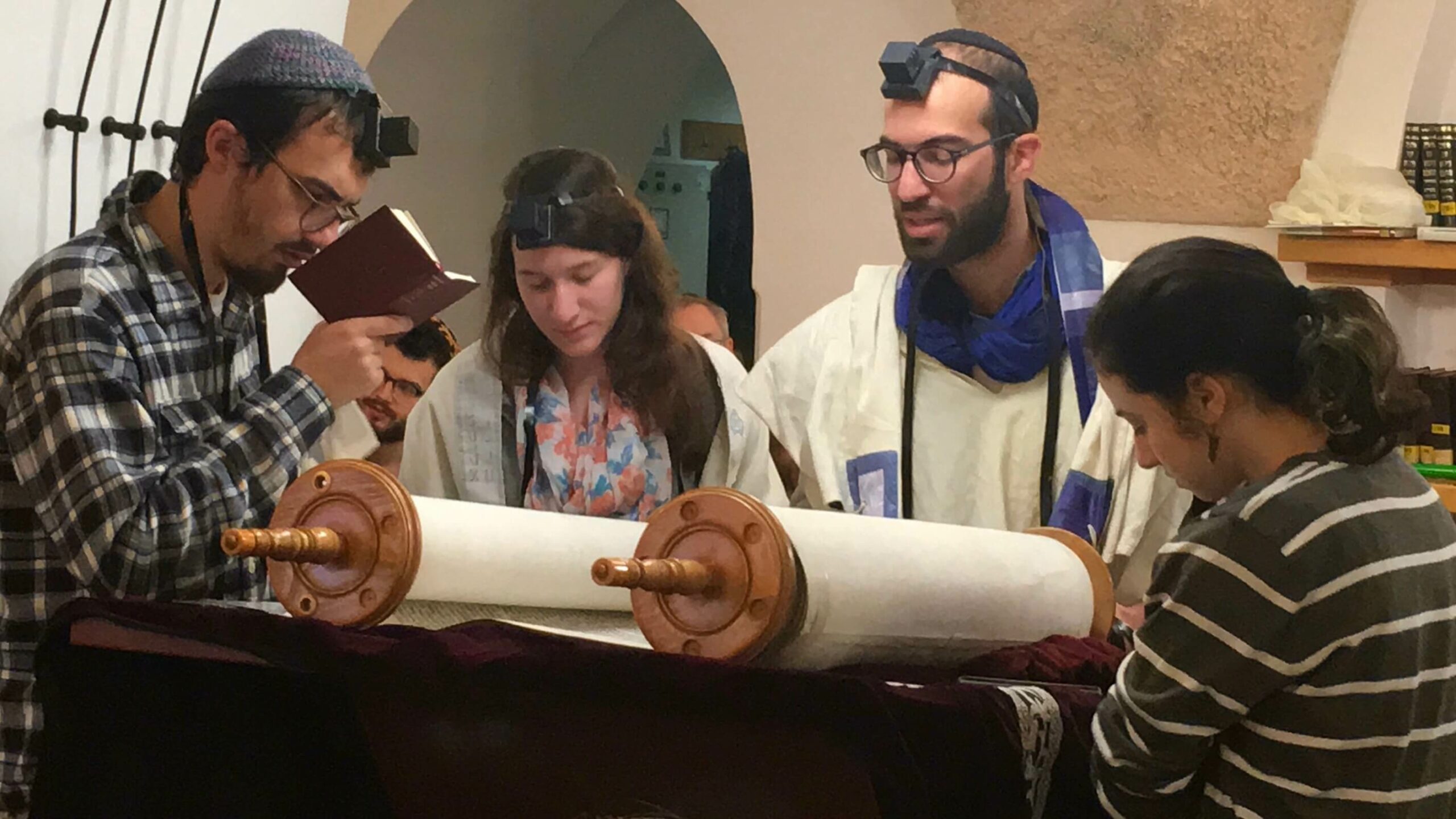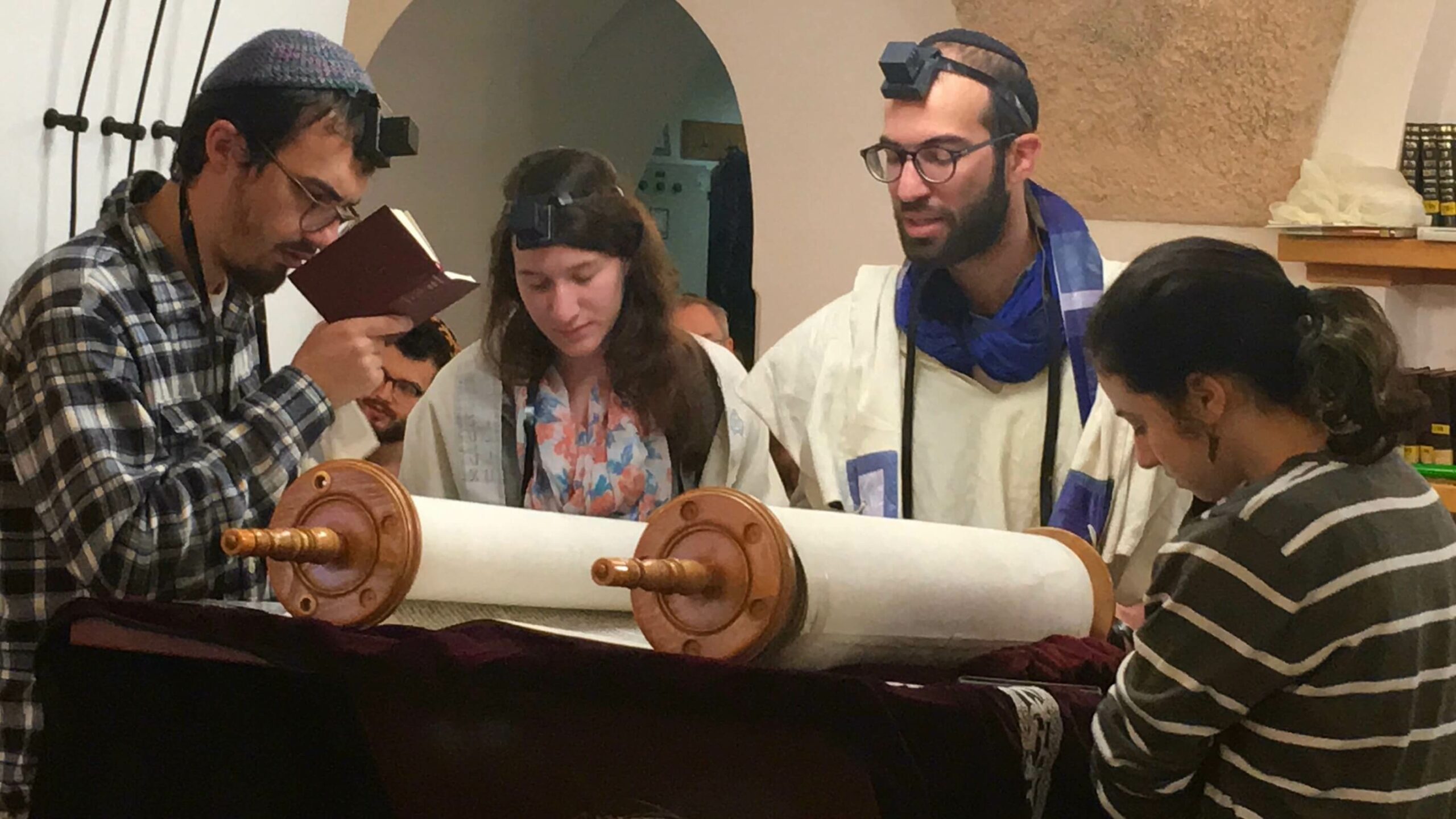

TORAH SPARKS
Parshat Behar-Bechukotai May 16, 2020 | 22 Iyar 5780
Annual | (Lev. 25:1–27:34): Etz Hayim p. 738
Triennial | (Lev. 25:1-38): Etz Hayim p. 738
Haftarah | (Jeremiah 16:19-17:14): Etz Hayim p. 763
Toiling in Torah Rabbi Leah Jordan
Conservative Yeshiva Student, 2019-20
God yearns for us to toil in Torah. So says the Sifra about this week’s parsha, Behar-Behukotai, on the famous opening verse, “If you walk in My laws and keep my mitzvot.” (Leviticus 26:3)
We must be “amilim ba-Torah.” The verb ah-mal, toil, suggests physical labor, but perhaps also emotional or spiritual work. It implies, too, that the work might be hard, maybe even inherently a struggle. And God’s “yearning” for us to do this toil shows God’s own desire to be in relationship with us through it.
For the past two years, I forsook life partner, career, and home to toil in Torah in Jerusalem. So I’ve been asking myself if I might have any insight into what this toil might entail.
First, like any work, you need tools, teammates, guidance, sustenance. I have found that toiling in Torah can be lonely work. It is in some ways ascetic. Early mornings and late evenings. For me, a lot of oatmeal and no partner to come home to. Putting a lot of one’s physical desires (for the sun! outdoors!) on hold and living on a student budget.
The companionship of the beit midrash therefore is everything. And the devotion of my chevrutas, the expectation that they were waiting for me to start the work together, made plowing the furrows together possible. And the mentorship of my teachers, who in the analogy of ‘toil’ are not the bosses but perhaps rather the foremen, set an example that we all strove to follow. Their one-on-one feedback, their care and relationship tending, made the toil worthwhile.
The Talmud says that the “competition of scholars increases wisdom.” In my experience, this is true, but also a difficult reality. One of the most paradigmatic yeshiva buchers I know, when I asked them what their main experience of toiling in Torah was, said they were angry a lot of the time. In my experience, toiling in Torah involves a lot of fighting one’s own demons of ego and intellect and expectation.
At the same time, if the toil happens only in the beit midrash, surely it is not fulfilling the command of this parsha to walk in God’s ways, which must also be in the world. Life goes on. And as the pandemic crashing into us in the middle of our second semester at the Conservative Yeshiva proves, our toil in Torah is not an island outside of time, but intimately vulnerable to the world’s shared struggles. God’s yearning for us to follow in Their ways through this engaged struggle means questions of spiritual and moral purpose are real.
All of us who have sat in the Conservative Yeshiva’s beit midrash are lucky. We have had the privilege to meet God’s yearning for us through our toil. I certainly felt so every day. I hope that our toil will bear fruit. Our toil in Torah must be translated into mitzvot, acts of toil in and for the world. Just like the toil in the beit midrash, this work is ongoing and requires many partners to sustain us. Walking in God’s laws in this way is intense and joyful and painful and necessary.
D’var Haftarah: God’s Redemptive Healing
Rabbi Mordechai Silverstein, From the Archives
At the conclusion of the haftarah, Jeremiah offers this prayer to God: “Heal me, O Lord, and let me be healed, save me and let me be saved for You are my glory.” (Jeremiah 17:14) This prayer is a reaction to Jeremiah’s pain. His pain was not physical. Instead it was a reflection of the harsh message he was burdened to carry. According to Abrabanel, the 15th century Spanish commentator, it was a response to what Jeremiah prophesied in a previous chapter: “Why is my pain perpetual and my wound incurable so that it refuses to be healed? Will You [God] be to me a deceitful brook, as water that fails?” (Ibid. 15:18) In this verse, Jeremiah expresses his angst over his difficult position as a prophet.
Jeremiah’s prayer, then, is not for a physical cure but for a feeling of God’s redemptive hand. Moreover, it is the prayer of an individual, the prophet Jeremiah, expressing his own needs before God.
This individual prayer is the basis for the eighth blessing of the Shemoneh Esreh, the weekday Amidah. In this blessing we beseech God to bring healing to the sick of the community: “Heal us, God, and we will be healed. Save us and we will be saved, for You are our glory.” The rabbis have turned Jeremiah’s individual prayer into a communal prayer. This transformation, however, presents a problem, since the rabbis posited that Biblical verses should not be altered: “A verse written in the singular should not be transformed into the plural; a plural verse should not be transformed into the singular” (Tosefta Megillah 3:41 – London Manuscript – see Lieberman, Tosefta Kifshuta).
Rabbi David Abudraham, the 14th century Spanish liturgical commentator, offered a number of solutions to this question: “According to Rabbi Meir Halevi Abulafia, the 12th century Spanish Talmudist, this law only refers to the translation of Biblical verses, but when the use is for prayer it is permitted to change verses as necessary.” Rabbenu Yonah, the 13th century Spanish Talmudist and moralist, limited the application of the law from the Tosefta to situations where the verse is quoted within its literary context, but where the verse is removed from its context for the purpose of prayer, changes are permissible.” (adapted from Abudraham Hashalem, Wertheimer edition, p. 99)
The sages realized the impact of the words of Jeremiah’s individual prayer and used them as a means for expressing the concerns of the entire community. The Jewish tradition teaches us through this process to look beyond our individual concerns and to pay attention to those around us. This is a crucial element of Jewish prayer and the basis of true religiosity. It is also an essential lesson for modern people.
When Earth’s LandLORD Thinks We Broke the Lease Terms!
Vered Hollander-Goldfarb, Conservative Yeshiva Faculty
Text: Vayikra 25:2-4, 26:34-35, 43
(25:2) Speak to the Israelite people … ‘when you enter the land that I am giving to you, the land shall observe a Shabbat of the LORD. (3) Six years you shall sow your field…and gather in [the land’s] yield. (4) But in the seventh year the land shall have an absolute Shabbat -a Shabbat to the LORD; you shall not sow your field…
(26:34) Then shall the land compensate for its Shabbat years…while you are in the land of your enemies… (35) Throughout the time that it is desolate, it shall observe the Shabbat that it did not observe in your Shabbat years while you were dwelling upon it… (43) And the land shall be forsaken of them and it shall compensate its Shabbat years by being desolate of them…
- The Shmita year is called the “the Shabbat of the Land”. How is it marked? How does it share the idea of Shabbat? (Take a moment to think what Shabbat is about – what do we declare by keeping Shabbat?)
- In chapter 26 we are given the terms of the contract: If you follow God’s commandments you will be blessed with plenty of good, if you turn away from the laws, a long list of horrors will happen. As part of these penalties we are told that we will be exiled from the land, leaving it desolate. What is the narrative that the Torah offers for such a situation in our text?
Midrash: Sifra Behukotai 8:9
“And the land will be forsaken of them, and it will compensate its Sabbaths”: I told them to sow for Me six (years) and to let it lie fallow for Me for one year, so that they should know that the land is Mine, and they did not do so — Arise and be exiled from it! and it will lie fallow of itself, all the Shmitah years that it owes Me, viz.: “And the land will be forsaken of them, and it will compensate its Sabbaths in being desolate of them.”
- According to the Midrash, what idea of Shabbat do the day of Shabbat and the year of Shmita share?
- What does our lease on Earth look like? What is the logical penalty for breaking the terms?
- How might the land (or the cities) ‘laying fallow’ be translated into today’s reality, whether as a description of current situations or a planned action?
KAYITZ BABAYIT: CY SUMMER – AT HOME!
The CY is bringing our signature CY Summer in Jerusalem experience to the comfort of your own home.
Sunday June 21 – Friday July 10, 2020





